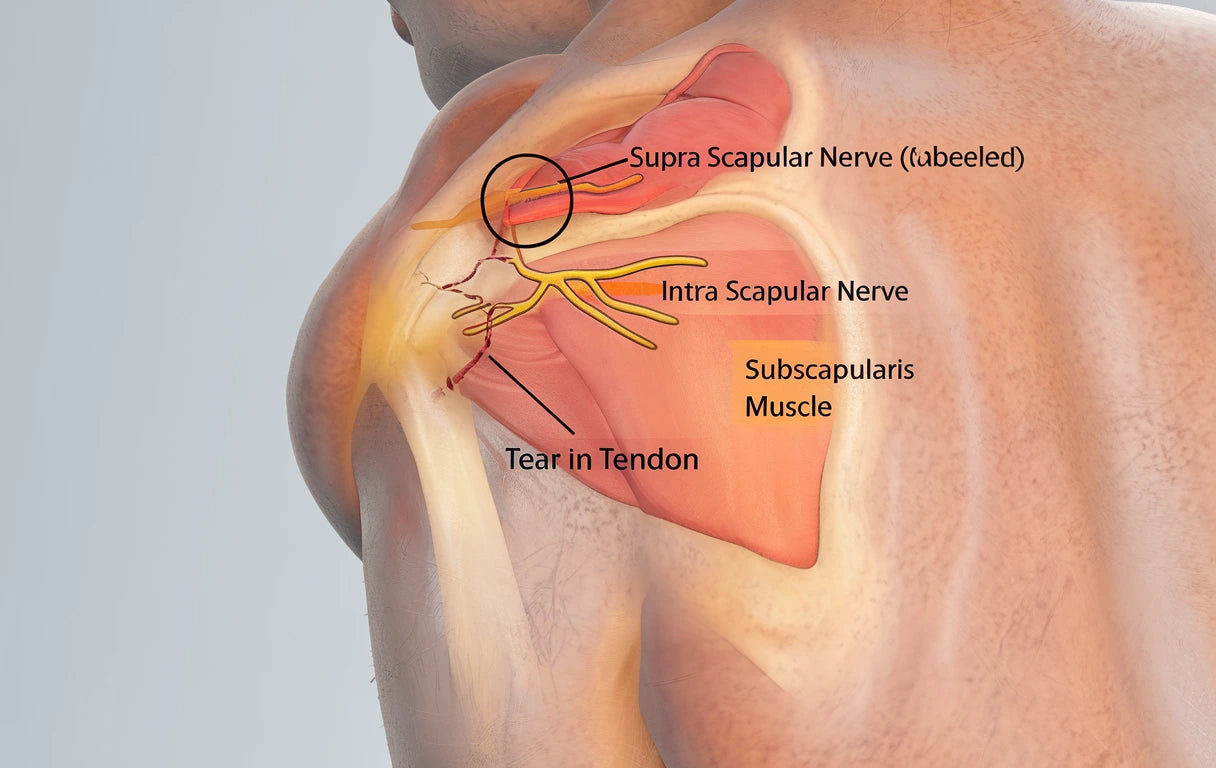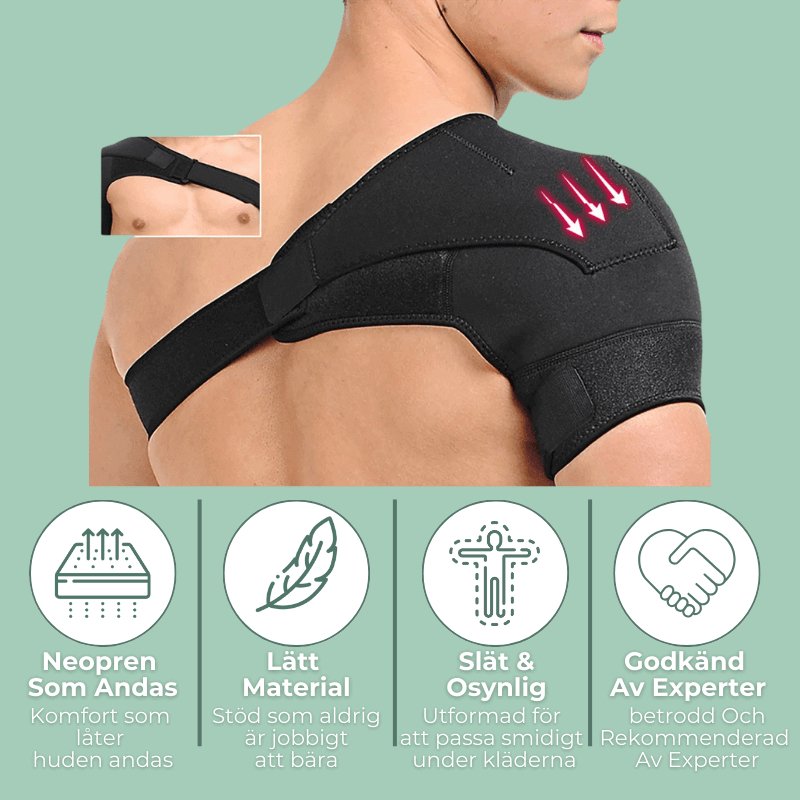Nerve Compression in the Shoulder: Symptoms, Causes, and Treatment

Shoulder nerve entrapment, also known as shoulder entrapment, is a condition in which a nerve in the shoulder area becomes pinched or compressed. This can lead to a variety of symptoms that affect shoulder function and cause discomfort. In this article, we will review the most common symptoms, causes, and treatment options for shoulder nerve entrapment.
Definition and understanding: Nerve compression and impingement in the shoulder
When a nerve in the shoulder is pinched, it can cause radiating pain from the shoulder down the arm, tingling, numbness and reduced mobility. Common causes include muscle tension, injury, inflammation and poor posture. Early diagnosis and treatment with rest, physiotherapy and support are crucial to relieve the pain and prevent the condition from worsening.
Pinched nerve in the shoulder symptoms - this is what it feels like
A pinched nerve can cause a variety of symptoms, often worsened by specific movements or at night.
Common signs of nerve compression in the shoulder:
- Pain and tenderness in the shoulder, which may be sharp, burning, or aching
- Pain in the shoulder that radiates into the arm – sometimes all the way down to the hand
- Tingling and numbness in the arm, hand, or fingers
- Muscle weakness in the arm that makes it difficult to lift or carry
- Limited mobility in the shoulder joint, especially when lifting overhead
- Worsened pain at night or while resting
- In impingement: pain when the arm is lifted to the side or forward, often due to compression of the supraspinatus tendon
Common causes of pinched nerve in the shoulder and shoulder blade
Common causes of pinched nerve in the shoulder and shoulder blade:
- Wear and tear of the shoulder joint with age
- Rotator cuff injuries that create pressure on nerves
- Inflammation that narrows the space where the nerve passes
- Poor posture leading to nerve compression in the shoulder and neck area
- Overuse of the shoulder due to repetitive movements or heavy loads
- Thoracic spine problems that affect shoulder biomechanics
Impingement often occurs when tissues around tendons and muscles swell, which can cause these structures to become pinched when the arm is lifted.
Pinched nerve in the shoulder blade – treatment with effective methods
A pinched nerve in the shoulder blade can cause pain, tingling, and weakness that radiates to the shoulder, neck, or arm.
Treatment aims to reduce pressure on the nerve, relieve pain, and restore normal mobility.
Physical therapy
Individually tailored exercises strengthen the shoulder muscles and increase mobility in the shoulder area.
Advantage of AxelKomforten™: Provides support during exercise and promotes correct posture to relieve pressure on the nerve.
Pain relief
Anti-inflammatory medication or natural pain relief methods can reduce inflammation around the shoulder.
Advantage of AxelKomforten™: Can reduce the need for medication through stable support and natural relief.
Ultrasound-guided treatment
In more severe cases, the doctor may give cortisone injections or perform hydrodissection to reduce pressure around the nerve.
Advantage of AxelKomforten™: Complements medical treatment and helps keep the shoulder in the correct position during recovery.
Posture correction
Improving the position of the shoulder in everyday life reduces the risk of further nerve damage and pain.
Advantages of AxelKomforten™: Helps you maintain a natural and ergonomic posture.
Clinical assessment
An examination by a doctor or physical therapist is essential to determine which structures are affected.
Treatment focuses on strengthening the muscles around the shoulder, improving mobility, and reducing inflammation.
With the right treatment strategy and support such as AxelKomforten™, most patients can return to pain-free shoulder function.

Shoulder Comfort™ – Advanced Support and Relief
For those looking for a natural and practical way to relieve shoulder strain , AxelKomforten™ can be part of the treatment. It:
- Provides support and reduces pressure on the nerve
- Helps improve posture
- Can be used during daily activities
- Supports rehabilitation exercises
- Reduces the need for pain relief through natural relief
For people with impingement, AxelKomforten™ helps position the shoulder blade correctly, allowing more room for movement without pinching tissues.
Buy nowSummary
Shoulder impingement can be a painful and disabling condition, but with proper diagnosis and treatment, most people can experience significant improvements. By combining medical treatments, physical therapy, and the use of supportive devices such as the Shoulder Comfort™, many people can effectively manage their symptoms and regain normal shoulder function. It is important to seek professional help early to prevent the condition from worsening and to begin an effective treatment plan.
For best results, avoid activities that aggravate symptoms and follow your treatment plan carefully. With persistence and the right measures, many patients can avoid major complications, such as shoulder osteoarthritis and other long-term problems.
Frequently Asked Questions (FAQ)
1. What are the most common pinched nerve symptoms in the shoulder?
Common symptoms include pain and tenderness in the shoulder, tingling and numbness in the arm, and muscle weakness. Many also experience limited mobility and pain in the shoulder that radiates into the arm, especially when lifting overhead.
2. What does it mean to have shoulder pain that radiates into the arm?
It usually means that a nerve is irritated or pinched in the shoulder, causing pain to spread from the shoulder joint down the upper arm and sometimes all the way to the hand. This is one of the most typical signs of nerve compression.
3. What treatment methods are used for nerve compression in the scapula treatment?
Treatment may include physical therapy, posture correction, anti-inflammatory medication, and relief with aids such as AxelKomforten ™. The goal of nerve compression treatment is to reduce pressure on the nerve and improve mobility.
4. How quickly do pinched nerve symptoms in the shoulder disappear with treatment?
With early diagnosis and proper treatment, symptoms can begin to improve within a few weeks. In more severe cases, recovery can take several months.
5. Can you exercise despite a pinched nerve in your shoulder?
Yes, but the exercise should be adapted. A physiotherapist can provide exercises that strengthen the shoulder without worsening the symptoms of a pinched nerve in the shoulder. Avoid heavy lifting and movements that cause pain in the shoulder that radiates into the arm.

